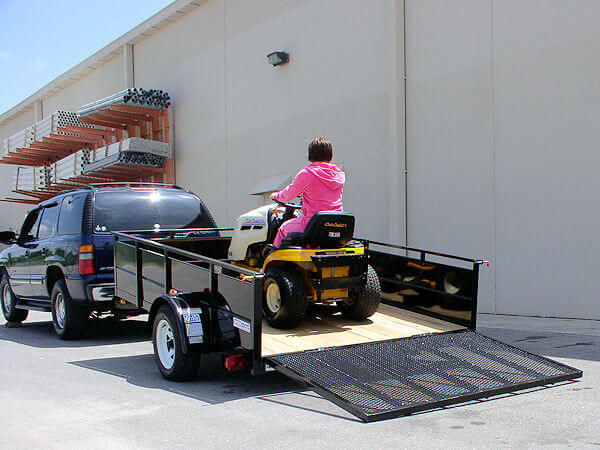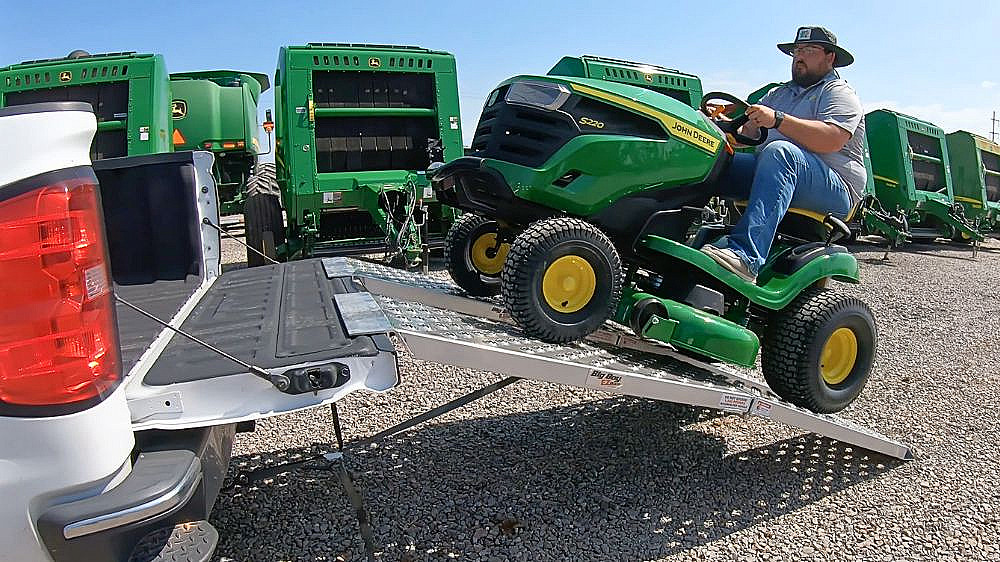As an Amazon Associate, I earn from qualifying purchases
Riding lawn mower transport is simple with a trailer or ramps. Whether moving it from home to a vacation property, find the best methods for safe transport here.
One option is to use a trailer, which can be attached to a vehicle and used to tow the lawn mower. It is also possible to drive a lawn mower onto a truck or trailer using ramps.
Both options require careful planning and execution to ensure safety and prevent damage to the lawn mower. We’ll go over both methods and tips for transporting your riding lawnmower.

Choosing The Right Trailer
Riding lawn mowers need the right trailer to be transported safely and efficiently. Trailer size, weight capacity, and hitch compatibility should all be considered when choosing one.
Consider The Size And Weight Capacity
- Choose a trailer that can accommodate the dimensions of your riding lawn mower.
- Ensure the trailer has the appropriate weight capacity to support the mower safely.
-
Check the trailer’s maximum load capacity to avoid overloading and potential safety hazards.
Ensure Proper Hitch Compatibility
- Verify that the trailer has a hitch compatible with your towing vehicle.
- Check the hitch class and weight rating to match your vehicle’s towing capacity.
- Utilize a secure hitch mechanism to prevent detachment during transportation.

Securing The Mower
When transporting a riding lawn mower, securing it properly is crucial to ensure safety and prevent any damage to the equipment. Here are some essential steps to follow for securing the mower during transportation.
Use Ratchet Straps For Stability
Ratchet straps are an effective way to secure a riding lawn mower during transportation. These straps provide stability and prevent the mower from shifting or tipping over. To use ratchet straps, follow these steps:
- Position the riding lawn mower onto the trailer or truck bed.
- Attach the ratchet straps to the front and rear of the mower, ensuring they are tightly secured.
- Tighten the straps using the ratchet mechanism to secure the mower in place.
- Check the straps for any signs of looseness or slippage before hitting the road.
Preparing The Mower
Before transporting a riding lawn mower, it’s essential to properly prepare the equipment to ensure a safe and secure journey. This includes removing attachments and accessories and securing moving parts to prevent any damage during transportation.
Remove Attachments And Accessories
Start by removing all attachments and accessories from the riding lawn mower. This includes items such as baggers, mulching kits, and other removable components that are not essential for transportation. Store these items securely to prevent loss or damage during the move.
Secure Moving Parts
Next, it’s important to secure the moving parts of the riding lawn mower. keep the mower deck fixed during transit, bungee cords or straps can be used. You should also secure the steering wheel and any other movable components to prevent them from shifting or causing damage to the mower.
Loading The Mower
When transporting your riding lawn mower, proper loading onto the trailer is crucial to ensure safety and prevent damage. To secure your mower on the trailer, follow these steps.
Drive The Mower Onto The Trailer Carefully
Before loading, ensure the trailer is on a level surface and properly attached to the towing vehicle. Slowly drive the mower onto the trailer, ensuring the wheels are aligned with the trailer’s ramps. Engage the parking brake and turn off the mower’s engine once it’s in position.
Check For Balance And Stability
Inspect the positioning of the mower on the trailer to ensure it is balanced and stable. Adjust the placement if necessary to distribute the weight evenly. Secure the mower using straps or wheel chocks to prevent shifting during transportation.
Securing The Trailer
Securing the trailer properly is crucial when transporting a riding lawn mower. It ensures the safety of both the equipment and everyone on the road. Here are important steps to follow to secure the trailer when transporting a riding lawn mower:
Check Tire Pressure And Hitch Connection
Before loading the riding lawn mower onto the trailer, ensure that the trailer’s tire pressure is at the recommended level. Proper tire pressure helps in maintaining stability during transportation. Additionally, check the hitch connection to the towing vehicle. It should be secure and free from any signs of wear or damage.
Use Safety Chains
When securing the trailer, always use safety chains. These chains act as a backup in case the main hitch fails. They should be crossed under the trailer tongue and securely attached to the towing vehicle. Ensure the chains are the correct length and not dragging on the ground, but with enough slack to allow for turning.
Driving Safely
Transporting a riding lawn mower requires proper preparation. Secure the mower on a trailer with sturdy straps, ensure the weight is evenly distributed, and drive at a safe speed.
Maintain A Safe Speed
Always maintain a safe speed when transporting a riding lawn mower.
Avoid Sudden Stops And Sharp Turns
Avoid sudden stops and sharp turns to prevent accidents and damage.
Unloading The Mower
Transporting a riding lawn mower can be tricky, but unloading it safely is just as important. Before unloading, check the ramp and make sure the mower is positioned correctly. Slowly lower the mower and ensure it is on level ground before removing the straps.
Use Caution When Unloading
Unloading a riding lawn mower requires careful handling to prevent accidents. Ensure the mower is securely positioned before attempting to unload it. Use proper lifting techniques to avoid straining your back during unloading.
Ensure The Area Is Clear
Before unloading the mower, ensure the <strong>surrounding area is clear of obstacles. Check for uneven ground that could cause the mower to tip over during unloading. Keep bystanders at a safe distance to avoid any potential accidents. Remember to use caution and check the surrounding area before unloading the riding.
Routine Maintenance After Transport
wt-guid=”7bfd9917-cd11-4fb5-a750-791602ca33c7″ data-pm-slice=”1 1 []”>After transporting your riding lawn mower, performing routine maintenance is crucial to ensure it’s in optimal condition for use. Below are key steps to ensure your mower is ready for action.
Check For Damage
- Inspect the exterior for any visible damage or dents.
- Check the tires for any signs of wear or punctures.
- Ensure all parts, such as the deck and handles, are securely in place.
Inspect Blades And Belts
- Examine the blades for any nicks, bends, or dullness.
- Check the belts for proper tension and signs of wear.
- Ensure blades are properly aligned and securely fastened.
Legal Requirements And Regulations
Transporting a riding lawn mower is subject to legal requirements and regulations. Obtaining proper permits and documentation is essential to understanding local transport laws.
Understand Local Transport Laws
- Check local laws regarding the transportation of oversized equipment.
- Ensure compliance with weight restrictions and safety regulations.
- Verify if special licensing or certifications are required for moving a riding lawn mower.
Ensure Proper Permits And Documentation
- Obtain any necessary permits for transporting the riding lawn mower.
- Keep copies of vehicle registration, insurance, and any relevant paperwork.
- Follow guidelines for securing the mower during transport to prevent accidents.

Professional Transport Services
Professional transport services are a convenient and efficient way to transport riding. Hiring professional movers to transport your riding can alleviate the stress and hassle of moving such a heavy piece of equipment. Let’s explore the benefits of utilizing professional transport services for your riding lawn mower.
Consider Hiring Professional Movers
Professional movers have the expertise and equipment necessary to safely and securely transport your riding lawn mower from one location to another. They are experienced in handling large and heavy items, ensuring your mower is transported without damage or complications. By entrusting the transportation of your riding lawn mower to professionals, you can save time and avoid the physical strain of trying to move it yourself.
Benefits Of Professional Transport
- Expertise: Professional movers are skilled in handling heavy machinery and understand the best practices for transporting riding.
- Time and effort can be saved by hiring professionals to streamline the transportation process.
- Safety: Professional transport services prioritize safety, minimizing the risk of damage to your riding lawn mower during transit.
- Convenience: By enlisting the help of professional movers, you can focus on other aspects of your move while ensuring your riding lawn mower is in capable hands.
Frequently Asked Questions
How To Load Into A Truck?
To load a riding mower into a truck, carefully drive the mower up ramps into the truck bed. Use straps to secure the mower in place. Be sure to follow safety guidelines and check the weight capacity of your truck.
How Do You Move?
To move a riding lawn mower, engage the parking brake, turn off the engine, and shift into neutral. Push or use a trailer to transport it.
What Is The Best Trailer To Haul?
The best trailer for hauling a riding mower is a utility trailer with a sturdy frame and ramps for easy loading.
Conclusion
Transporting a riding lawn mower requires careful planning and preparation.
Transporting your mower safely and efficiently is possible by following the proper steps and using the right equipment. Whether for maintenance or relocation, these tips will help ensure a smooth and hassle-free process.
As an Amazon Associate, I earn from qualifying purchases

